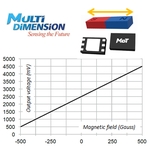York Instruments, a young UK company that specializes in highly sensitive magnetic measurements and their healthcare applications, has been expanding rapidly on several fronts recently in the field of magnetoencephalography (MEG) with an acquisition from Swedish medical equipment maker Elekta and some important placements of its equipment at leading medical institutions in Europe and the USA.
Additionally, through its parent company Croton Healthcare LLC and recent attention on sports-related brain injury, more implementation of its technology appears to be gaining momentum.
Yorks main product is Megscan which combines ultra-sensitive magnetic sensing with the latest developments in cryogenics and quantum technology to offer a new version of a magnetoencephalography (MEG) brain scanner.
Magnetoencephalography is commonly used for patients undergoing brain surgery due to epilepsy, trauma, stroke, or brain tumors. It affords functional brain imaging with detailed spatial and temporal resolution, able to detect extremely subtle brain signals. For clinicians, the information gained through it leads to better surgical outcomes, especially in cases of severe epilepsy or brain lesions and for surgical planning of localization of sensory information. Lately, there has been substantial interest in Megscan from investors and clinicians owing to its application to concussion injuries, an area which is attracting now a great deal of attention because of sports injuries.
Yorks genesis lies at the University of York in 2015 when a core team from York Neuroimaging Centre seized the opportunity to substantively upgrade the core magnetic field sensors and low noise electronics in their existing MEG scanner. After attracting significant US investment, the team established York Instruments as a new technology company.
Now based in York, the company was founded in 2015 and has been staffed by about 40 people between three offices in York and London in the UK, and Coral Springs, FL. With a range of biomagnetism products in its portfolio and on the horizon, the company has attracted over $20 million of investment funding. Its multi-disciplinary team links physicists with mechanical engineers with electronics experts with software interface designers.
Megsan represents a new approach to an old technology. Similar in scale to an MRI scanner, the magnetoencephalography scanner picks up minute magnetic signals passively emitted by the brain as a result of normal neural activity. MEG systems have been used in hospitals since the mid-1990s, mainly to characterize complex epilepsy cases and determine accuracy of location for brain surgeries.
York has designed its latest system to foster expanding the clinical utility for MEG to encompass new application areas. It has dedicated features that address the understanding of concussion injuries and has attracted interest from lead sports organizations such as the National Football League and National Hockey League. Clinical application areas of greatest immediate interest are the existing epilepsy market, new markets to support concussion, and positioning MEG as a key part of a multi-modal imaging approach to head traumas and brain cancers. Megsan is currently available for investigational use only; clinical regulatory approvals are anticipated in early 2019.

The quantum sensors need to be cooled to 4 Kelvin in order to pick up the minute magnetic fields emitted by the brain. This system design shows for the first time that MEG sensors can operate successfully in a cryogen-free environment using pulse tube refrigeration technology, said Chappell.
York is committed to continuing to invest in both research and clinical applications for MEG, said Chappell. Our vision is that MEG stands alongside MRI and other common imaging tools as a reliable, accurate workhorse staple for every neuroimaging department with the potential to positively impact the lives of thousands of patients.

Acquisition of MEGIN business
In July, York acquired its largest competitor, the MEGIN neural imaging line of business, from Elekta, a leading medical equipment manufacturer headquartered in Stockholm, Sweden. MEGIN, based in Helsinki, Finland for about 30 years, has been the largest provider of magnetoencephalography technology for functional brain imaging. More than 100 systems have been delivered worldwide.
It pioneered the system which York has advanced with its highly sensitive magnetic sensing and other technology. No figure was announced for the acquisition but MEGIN had sales of about $11 million (US) in the past year. In 2018 it launched the TRUIX neo model as its fourth-generation system introduced for the presurgical evaluation of epilepsy, brain tumors, or other lesions, and surgical planning for localization of sensory information.
Elekta has successfully developed the magnetoencephalography business over the past decade, explained Mauritis Wolleswinkel, Elektas head of portfolio and chief strategy office, but recently took the strategic decision that it is no longer a part of our core treatment solutions and oncology informatics business. Based in Stockholm, Elekta employs 3,600 people worldwide and is a leading provider of oncology diagnosis and treatment solutions using magnetic resonance imaging technology.

Baltzer is also CEO of Croton Healthcare LLC based in Coral Springs, Florida which is the parent company of York Instruments as well as the parent company of The Concussion Network, LLC, and Croton Healthcare Canada, Inc. An urgent need exists in the marketplace for a new magnetoencephalography device for brain imaging, including concussion, epilepsy, Alzheimers and autism, said Baltzer. Meanwhile, Crotons The Concussion Network is developing standalone sites for the commercial use of the equipment in the medical and athletic markets.
Megscan taking hold
York has recently signed agreements to place its systems at three leading neuroscience research universities in the UK and Germany. The University of York and the University of Glasgow in the UK, and Germanys University of Konstanz, will partner with York Instruments to further develop the technology, as well as pursue potential new applications.
By first incorporating Megscan core control electronics, the university researchers will achieve an improved signal to noise ratio through the improved low noise electronics. With the full Megscan system, they will have the capability to measure healthy and pathological brain signals with unprecedented sensitivity.
We are very pleased to be able to invite the Universities of York, Glasgow and Konstanz to be part of our growing network of pioneering MEG research and clinical sites worldwide looking to radically improve the field of magnetoencephalography, noted Baltzer.
 Under the hood
Under the hood
The Megscan system contains highly sensitivity magnetic sensors and offers cryogen-free operation, combined with modern electronics and software. At the heart of its equipment is an extremely sensitive magnetic sensor coupled with high-speed electronics to develop improved diagnostic capabilities.
The quantum sensors used in magnetoencephalography collect magnetic signals as a result of neuronal activity and can sense signals as small as 10-15 Tesla which is many orders of magnitude smaller than the earths magnetic field. Consequently, eliminating extraneous noise in electronics or cabling is of paramount importance.
York has designed a sophisticated set of control electronics to run their system. Modular and flexible, it is designed to allow York to expand the use of magnetoencephalography into other areas of clinical and research utility, exploring brain data in both ultra-low and ultra-high frequency bands. The modular design in each of the sensor assemblies means interfaces are exchangeable allowing for futureproofing as new quantum sensors become available.
The magnetic sensors used in Megscan are hybrid quantum interference devices, called HyQUIDs. Developed at Royal Holloway University in the UK, they are more sensitive and have a lower noise floor than SQUID technology which is traditionally used. The sensors allow for recording of slow wave brain activity and support clinical applications where slow waves are symptomatic of underlying pathology. The new sensors open the door to diagnostics of traumatic brain injury and post-traumatic stress disorder. At the other end of the spectrum, ultra-high frequency oscillations are also easily measurable.
MEGIN Truix neo
In November, Janne Huhtala, CEO of MEGIN, spoke about the future innovation of MEG technology at a neuroscience conference in Buenos Aires, the N20 Summit. Huhtala addressed how the use of functional brain imaging with MEG has impacted patient care and led to translational research of challenging neurological conditions. “The focus of the conference aligns with our corporate goals of innovating MEG technology and we look forward to supporting the clinical community in search of ways to better understand how the brain is connected, said Huhtala.”
“MEG is a great technology that has been neglected for years,” said Dr. Babak Kateb, chairman of the meeting and head of the Society for Brain Mapping & Therapeutics. “Our patients have been deprived access to this technology for decades. It is refreshing to see MEGIN has a convincing strategic plan to make this technology as prevalent and accessible as MRI.
A few months earlier, in September, Le Bonheur Childrens Hospital in Memphis, Tennessee, became the first hospital in the world to install TRIUX neo. Le Bonheur Childrens has a world-class neuroscience program. They are leaders in implementing innovative technologies that translate to better care and improved outcomes, said Huhtala. We are honored to be working with their amazing team of clinicians and researchers as we look to expand the clinical impact of our technology.
TRIUX neo can detect and localize neural events that are generated in the brain with millimeter accuracy and millisecond resolution. When this information is merged with structural MRI imaging, it provides a view to critical areas of the brain such as those areas responsible for the ability to see, talk, or move. Using this kind of information can confirm a diagnosis when other imaging modalities are inconclusive, thereby increasing the accuracy of surgical intervention and minimizing risk of neurological deficit, the company said.
We provide excellent care to children with neurologic diagnoses using advanced technology, clinical expertise and state-of-the-art facilities. As one of the nations best pediatric neuroscience programs according to U.S. News & World Report, we are looking forward to incorporating this new technology, said James Wheless, MD, chief of Pediatric Neurology for the University of Tennessee Health Science Center and co-director of Le Bonheurs Neuroscience Institute.
Using MEG, we determine the focus of seizures and can map sensory and motor areas, said Frederick Boop, MD, chair of the department of neurosurgery for the University of Tennessee Health Science Center and co-director of the Neuroscience Institute. This has allowed us to perform brain surgery in children more safely and with fewer complications. It has also allowed us to extend our surgical capabilities in children with epilepsy to those who might not have been recognized as surgical candidates in the past. This new technology will help us continue this important work.



